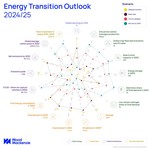What do the US mid-term election results mean for renewable energy?
A new analysis by Wood Mackenzie Power & Renewables assesses the political landscape of these states – i.e. Nevada, Colorado, Illinois, Michigan, New Mexico, Minnesota, Kansas, Wisconsin, Connecticut and Maine – and analyses the upside market potential for increased wind and solar if these governors move forward on their campaign promises through increases in their state Renewable Portfolio Standards (RPS).
Colin Smith, senior analyst at Wood Mackenzie Power & Renewables, said: "The midterm elections have created a tremendous upside for renewables in several state markets. The political landscape has shifted and may start to drive more wind in solar across the U.S."
On November 6, 2018, fourteen states elected governors from the Democratic party, “flipping” control of the office from Republicans in seven cases. Of these, three states saw a continuation of Democratic leadership under new candidates after term limitations on previous governors, while the remaining four states saw incumbents re-elected.
This has created a new political landscape where the probability of additional renewables build is greatly increased. All but two of the newly elected governors are in states that have joined the US Climate Alliance or campaigned on a pledge to join the alliance and commit to the Paris Agreement in lieu of federal participation. In each of these states, RPS increases are likely to be a major driver of renewable capacity additions at scale.
"Despite the federal government's choosing not to uphold the emissions-reduction commitments under the Paris Agreement, many of these states have independently committed to meeting or exceeding their goals through reduction of fossil fuel generation," said Smith.
Six of the ten newly elected Democratic governors proposed increases in RPS targets with three proposing 100% mandates. Most of the winning Democratic incumbents already recently increased their renewables targets significantly, including Andrew Cuomo in New York (50% by 2030 RPS), Gina Raimondo in Rhode Island (39% by 2035) and David Ige in Hawaii (100% by 2045). Only Tom Wolf in Pennsylvania has no recent RPS increase to speak of and did not include language supportive of a RPS increase in his campaign.
While the prevalence of gas-fired generation and the extremely low delivered gas prices in Pennsylvania suggest no RPS increase will be forthcoming, the Pennsylvania Department of Environmental Protection has released the final version of its Pennsylvania Solar Future report outlining how to bring the state’s solar power generation up from less than 1% to 10% by 2030.
"While the exact polices each governor elect will propose remain to be seen, our analysis of the total addressable market shows many states have potential for large renewables buildout if individual state RPSs are increased. This could create a new demand landscape for wind and solar in the U.S.," Smith added.
- Source:
- Wood Mackenzie
- Author:
- Press Office
- Link:
- www.woodmac.com/...
- Keywords:
- Wood Mackenzie, political landscape, USA, renewable energy, RPS, Democratic Party, 2030, Republicans






















